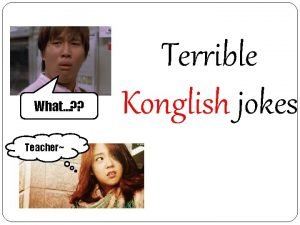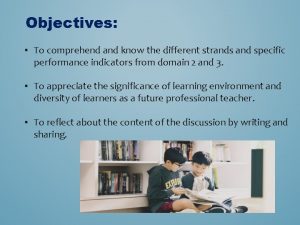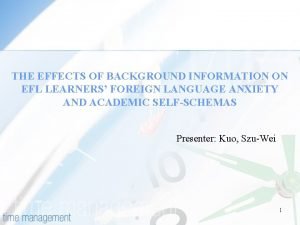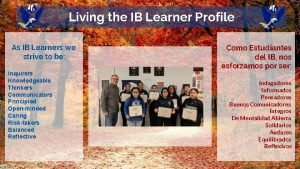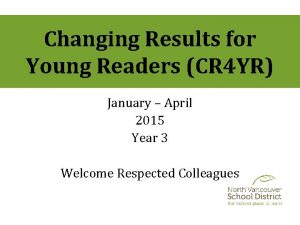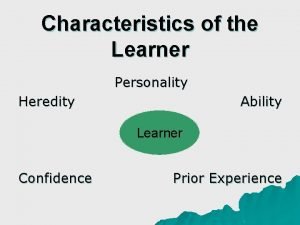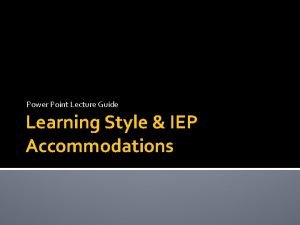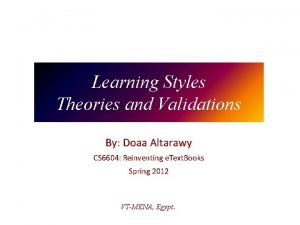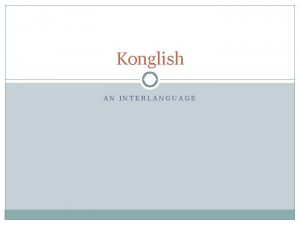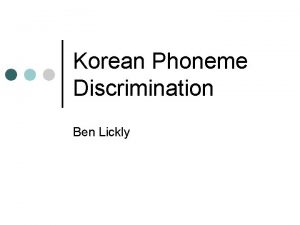Approaches to Konglish Korean L 2 learners unique
















- Slides: 16

Approaches to Konglish Ø Korean L 2 learners’ unique interlanguage arising from an impoverished knowledge of English Ø Konglish words will be reserved for lexical entities at the linguistic level, while the term Konglish will be applied to the whole range of Konglish phenomena, including socio-pragmatic aspects of language use. Ø The extent of the impediment to comprehensibility rather than the issue of “right” and “wrong”

Konglish as False Cognates The overlap between cognate pairs in two languages is not always apparent in orthography, even though meaning and phonology may be shared between the cognates (Grosjean, 1997, p. 230).

Loanwords from English in Korean Ø Ø Loanwords which are fully integrated into the Korean phonological system 테마 /tema/ (theme) Loanwords which retain more phonological features of L 2 싸인 /s’ain/ (sign) Ø Semantically identical cognates 커피 kopi (coffee) and coffee Ø Semantically dissimilar cognates 샤프 syapu (mechanical pencil) and sharp

Code Switching vs. Borrowing Code-switching is considered to be “the most available word phenomenon” (Grosjean, 1982, p. 151) and not necessarily to result from “dysfluency” (Green, 1986, p. 215). Borrowed forms become part of the matrix language mental lexicon and have their own matrix language lemmas in the matrix language mental lexicon, whereas code-switched forms remain clearly part of the embedded language and do not become part of the matrix language mental lexicon (Myers-Scotton, 1992, p. 21).

Konglish-English Equivalence Hypothesis Ø Konglish users perceive Konglish words to be equivalent to English words. Ø Borrowings from roman-alphabetic languages other than English are perceived as English and deployed in English-language contexts Ø Korean learners’ Konglish-English equivalence hypothesis may create an abnormal label for the Konglish words as “Konglish=English” Ø Under the Konglish user’s Konglish-English equivalence hypothesis, Konglish words tagged as “Konglish=English” may receive sufficient activation to reach the threshold first, the L 1 lemma may be selected in place of L 2 lemma.

Categories of Konglish Phenomena The Phonological Dimension Ø L 2 phonemic features absent from their native langue, /f/, /v/, /r/, /θ/ and /w/ respectively are replaced by /p/, /b/, /l/, /t/ and /u/, which are closer to Korean phonemes as in /kәpi/ (coffee), /bodka/, (vodka), /lais/ (rice), and /tema/ (theme) Ø L 2 syllable structure may often be modified to fit Korean patterns 트/tį/ 리/ri/ 트 /tį/ 먼/mən/ 트/tį/ for treatment.

The Grammatical Dimension Ø I fell down on the stairs and my arm was broken yesterday Ø marry with, Ø discuss about, Ø mention about, Ø describe about

The Dimension of Lexical Form ¢ Ø Ø Ø ¢ Ø Ø Clipping (one word missing) one piece (one piece dress) white (white-out; liquid solution, correction tape) complex (inferiority complex) one-room (one-room apartment or studio apartment) after service (after sales service or warranty) ball pen(ball point pen) Clipping (part of the word missing) accel(accelerator) gang(gangster) note(notebook) Contraction from two words remocon (remote controller) aircon (air conditioner) Non-native acronym formation DC(discount) BGM (background music) CF (commercial film) Blending leports(leisure + sports) officetel(office + hotel)

The Semantic Dimension When more than one semantic equivalent exists in the L 2, the split-categorization activates Konglish. For example, a single form 약속 has two equivalents, appointment/plans and promise, in English. ¢ Ø Ø Ø Ø ¢ Ø Ø Expansion (generalization) burberry coat(trench coat) coating(laminating) hip (rear, bottom or buttocks) Narrowing sign (signature or autograph) manicure(nail polish) glamour(a girl with a sexy figure) Innovation edge (fashionable) booking (an instant blind date) fighting!(go for it! or hurray!) magic pen (marker) meeting(blind date) one shot (bottoms-up!) open car (convertible) skinship(casual contact between lovers) Pejoration hostess (a woman who works at an adult bar) room salon(an adult bar)

The Collocational Dimension For language learners to achieve full control of collocations and prefabricated items, the associative networks need to be sufficiently developed in their second language lexicon. Ø strong drinker (heavy drinker) Ø sour and sweet (sweet and sour) Ø East, West, South, North (North, South, East, West) Ø 3 nights 4 days (4 days 3 nights)

The Conceptual Dimension (1) Language shapes the conceptual categories that influence how its speakers’ perceptions are encoded and stored (Wierzbicka, 1992). English-speakers narrate an event from their point of view Ø Ø Where am I ? I like your dress Konglish users describe it from a third-person perspective as an observer Ø Ø Where is here? Your dress is beautiful Speaker-orientation Ø Can I get some water? Hearer-orientation Ø Could you bring me some water? Ø Please bring me some water

The Conceptual Dimension (2) Underlying concepts profoundly affect the meanings attached to linguistic labels. Even in domains where two languages seem to divide the world up conceptually in broadly the same way, linguistic labels are often applied in different places (Swan, 1997). Ø half-boiled egg vs. soft-boiled egg Q: Aren’t you hungry? A: Yes Ø The respondent’s intention is in accordance with the true value “I am not hungry”

The Metaphorical Dimension § Metaphorical concepts and features are culture-specific (Lakoff & Johnson, 1980). § Certain features specifically emphasized and valued in the given culture affect the process of elaboration of metaphorical expressions (Kövecses, 2002, p. 186). Ø Turtle (snail) Ø Stone head (air head)

The Pragmatic and Discoursal Dimension § “Free” goods (Lakoff, 1974) Ø marital status and age § “Noticing”, especially lying in compliments in native speakers’ greetings (Hatch, 1984, p. 191) Ø Where are you going? Ø Did you eat your meal? § Korean L 2 learners often believe that the English speaker would not be offended by their “being less polite” or “being direct.

The Intercultural Dimension A lack of cross-cultural awareness may cause Korean learners to rely on K onglis h rooted in K orea n culture. C ulture a ls o determines the meanings perceived by thos e belonging to the c u l t u r e ( J a n d t , 2 0 0 1 ). Ø senior/junior Ø I’m sorry (for your loss)

Thank you
 Spectroscopy jokes
Spectroscopy jokes Remedial instructions
Remedial instructions Diversity of learners
Diversity of learners Teaching young learners english
Teaching young learners english Background information for learners
Background information for learners Kinesthetic imagery
Kinesthetic imagery Global vs analytical learners
Global vs analytical learners Ib learners profile
Ib learners profile Changing results for young learners
Changing results for young learners Learners will be able to
Learners will be able to Characteristic of learners
Characteristic of learners Principles of active learning
Principles of active learning Global vs analytical learners
Global vs analytical learners Impulsive learners
Impulsive learners Reading strategies for english language learners
Reading strategies for english language learners Quadrant d
Quadrant d When is cognitivism beneficial for learners
When is cognitivism beneficial for learners
